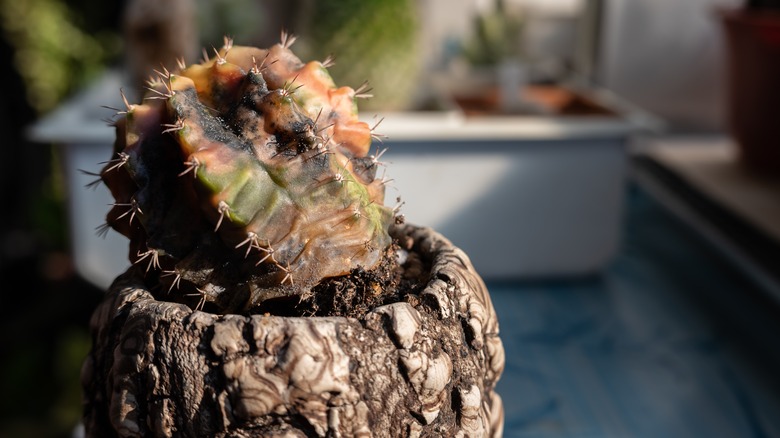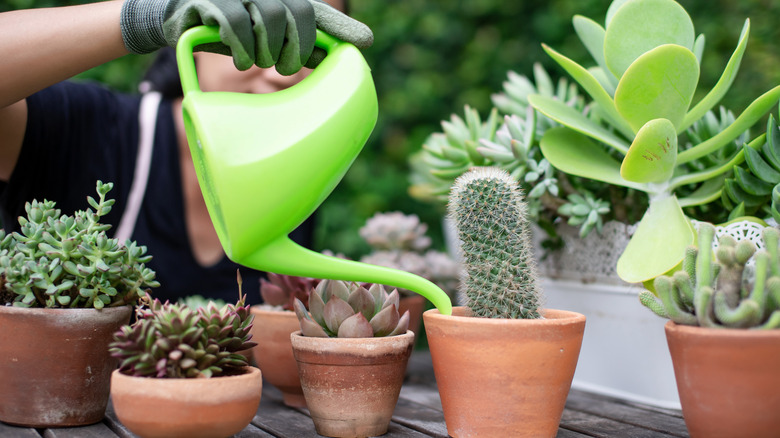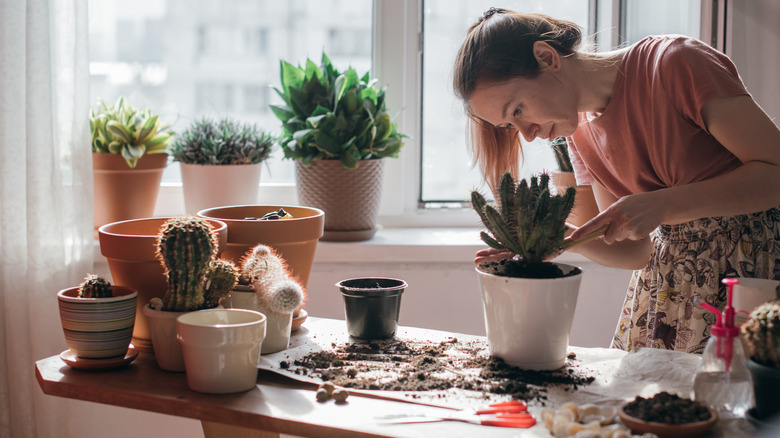How To Bring Your Dying Cactus Back To Life
While cacti are low-maintenance plants that thrive on neglect, that doesn't mean they're immune to sickness and disease. Luckily, cacti can be brought back from the brink of death by simply mimicking their natural conditions. Make sure that your plant baby hasn't been over or under-watered, has ample sunlight, and is living in well-draining soil.
Cacti are resilient and low-maintenance plants, which makes them ideal for container gardening and indoor settings. Overwatering or using slow-draining soil can lead to root rot, which will cause your cactus to droop and develop yellow, brown, or black discoloration. On the opposite side of the spectrum, under-watering will make your prickly buddy shrink as it draws on its moisture reserves. Cold temperatures and damp soil can also make your cactus droop and become mushy, while sudden exposure to intense sunlight will basically give it the plant equivalent of a third-degree burn.
If your cactus is rotting from the top down, this is known as tip rot and needs to be acted upon immediately. This rot can be caused by fungus, disease, or water entering an open wound on the plant, which makes it susceptible to infections. All the rot must be pruned off to prevent it from spreading any further.
How to save your dying cactus
If you notice your cactus is wilting, this is a sign that your little buddy isn't doing too well. Carefully check the roots to make sure they're slightly moist, and that the soil isn't excessively dry or wet. If there's too much water, then allow it to dry before giving it any more liquid. If the soil is super dry, give your cactus a nice big gulp of water. Additionally, if it is wilting but not yet dying, there is a chance to revive it. Place it in a well-lit area, keeping it away from direct sunlight.
The resurrection may take a couple of weeks, but if the cactus has been looking weak for an extended period of time, it might be too difficult or too late to bring it back from the brink. To prevent this traumatic experience from happening again, stick to a watering schedule and always monitor your soil. Be sure to water your cactus regularly, especially during warmer months. Remember that each variety of cactus has specific sunlight and watering needs, so educate yourself because one size does not fit all.
Try repotting your cactus
Repotting your dying cactus can be a simple yet effective way to revive it. Check the condition of the soil and keep an eye out for any roots that might be growing out of the bottom of the pot. This is a telltale sign that your little guy has outgrown his current home and needs transplanting right away. Even for healthy cacti, repotting every few years is beneficial. Make sure you choose a new pot with drainage holes.
Fill the plant's new digs with fresh cactus soil, which can be found at home improvement stores. Alternatively, you can make your own using peat moss, coarse sand, and perlite or pumice stone. After repotting, water the cactus thoroughly and allow it to sit for about 15 minutes before adding more water if needed. Finally, give it time to adapt and recover. It's just been through the ringer, so it might look a little haggard at first.


